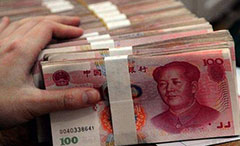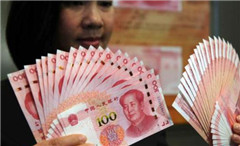China mulls new yuan pricing formula to raise stability
2017-05-29
Xinhua
BEIJING — China plans to change a formula for forming the yuan-US dollar central parity rate, a move to ensure stable exchange rates at a time when global financial markets remains beset by instability.
Under China’s market-based, managed floating exchange rate regime, the yuan can rise or fall by 2 percent against the US dollar from the central parity rate each trading day. The central parity rate is a weighted average of quotes from dealer banks, and follows a formula of previous day’s closing rate and changes in a basket of currencies.
The new formula, announced on May 26 by the China Foreign Exchange Trade System (CFETS), will allow dealers to incorporate a “counter cyclical factor” into the existing formula.
China’s forex market is easy to be influenced by irrational expectations and spurred by inertia, due to a certain level of “pro-cyclicality,” which distorts market demand and supply, and magnifies the risk of exchange rate overcorrection, the CFETS said in a statement.
The proposed adjustment aims to “appropriately hedge against the pro-cyclical fluctuation in market sentiment and alleviate the potential for herd behavior in the forex market,” it said.
The CFETS said the “counter cyclical factor” would be adjusted in accordance to China’s economic performance, but it did not give further details about how and when the potential new formula would be used.
CICC analyst Chang Huili said the “counter cyclical factor” might be adjusted according to a number of economic indicators, particularly those on growth and inflation.
The “counter cyclical factor” could counteract the impact of the previous day’s excessive volatility by reducing the closing rate’s role in the next day’s central parity rate, and help ensure the general stability of the yuan exchange rate, according to Commerzbank AG senior EM economist Asia Zhou Hao.
CFETS noted on May 26 that the yuan-dollar market exchange rates had recorded lower levels from the central parity rate, despite China’s improving economic fundamentals and a weakening greenback.
According to CICC, the yuan has depreciated 2.7 percent this year against the CFETS basket, in contrast to the notable improvement in economic fundamentals this year.
“The new formula will enable the yuan-dollar exchange rate movements to be more independent and better reflect the domestic economic fundamentals,” Chang Huili said.
Chang expects the yuan to be well supported by China’s economic fundamentals this year, saying that although China’s economic growth may experience a “soft-path” due to the ongoing liquidity tightening and financial deleveraging, a prolonged period of slowing growth slowdown is not likely.
This comes amid China’s efforts to push reform to the yuan’s exchange rate formation system to make the currency more market-oriented and internationally recognized.
In October 2016, the yuan joined the dollar, euro, pound and yen in the International Monetary Fund’s special drawing right (SDR) currency basket.
“After joining the SDR basket, the yuan’s better reflection of domestic economic and financial performances has become an important precondition to help diversify global risk, and a solid foundation for the internationalization of the currency,” said Meng Xiangjuan, an analyst at Shenwan Hongyuan Securities.
“China’s efforts to seek a balance between making the yuan exchange rate more flexible and keeping it more stable is good for the global community, avoiding negative spillover effects from the yuan’s disorderly adjustment or competitive currency devaluations,” said Pan Gongsheng, deputy governor of the People’s Bank of China.
Zhao Qingming, chief economist at the China Financial Futures Exchange, said more work needed to be done to further expand China’s forex market and enhance flexibility of the yuan exchange rate.


